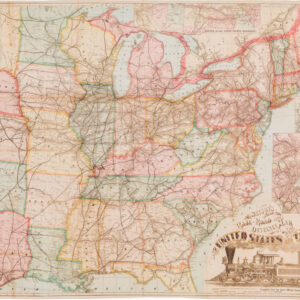A stunning view of Brooklyn, heralding consolidation with New York City.
Bird’s-eye view of the borough of Brooklyn showing parks, cemeteries, principal buildings, and suburbs.
Out of stock
Description
A large and impressive bird’s eye view of Brooklyn drawn by artist George Welch and published in 1897 as a supplement to the Brooklyn Daily Eagle. The view was prepared in tandem with Brooklyn’s incorporation into the City of Greater New York as a borough.
The view depicts Brooklyn from the direction of Manhattan, looking towards the southeast, with downtown Brooklyn in the foreground and with Coney Island, Rockaway, and Jamaica Bay in the background. The attention to detail is truly stunning, with individual buildings distinctly illustrated, including churches, factories, warehouses, and the Brooklyn Daily Eagle‘s own building and the nearby Post Office building downtown. Parks, squares, cemeteries, and distant suburbs (many in Queens – Morris Park, Woodhaven, Jamaica, etc.) are labelled throughout, as are landmarks like the Brooklyn Navy Yard. The tram line leading to the Brooklyn Bridge in the foreground may refer to the first trolley line across the bridge, opened in January 1898.
Although showing the sprawl of Brooklyn in the late 19th century, the view is also a reminder as to how recently much of the borough remained farmland. In the following years, very high levels of immigration (including domestic migration, primarily African-Americans from the South) to the now-consolidated New York City would further transform Brooklyn, filling in the farms and villages seen here with a dense urban environment.
The consolidation of New York City
The consolidation of Brooklyn (and Queens and Staten Island) into New York City on January 1, 1898 was the key event that gave the modern metropolis its shape. Prior to consolidation, Brooklyn was an independent city that had a history of European settlement dating back to the 17th century, and Native Americans long before that. The city had grown rapidly during the 19th century, fueled by immigration and industrialization, and by the mid-19th century was the third-largest city in the United States, after New York City and Philadelphia. It had its own economy, government, and public services, but it faced increasing challenges, particularly with infrastructure and the cost of services. Over time, the argument for combining the governmental efforts of New York City (Manhattan and, since 1895, the Bronx) and surrounding areas, especially Brooklyn, would be more efficient and cost effective. The opening of the Brooklyn Bridge in 1883 greatly enhanced the logic of this argument, vastly improving the earlier system of ferries that was unable to meet demand for travel of goods and people across the East River.
Although there was considerable reluctance and even opposition in Brooklyn to losing its distinct identity and government, by the 1890s the momentum was clearly towards consolidation. On December 1894, voters in Brooklyn narrowly approved a referendum to join New York City, which took place on New Year’s Day 1898. Although governance was largely centralized from offices in Manhattan, a degree of autonomy was retained through the offices of the Borough Presidents and county government functions (Kings County in the case of Brooklyn). Culturally, Brooklyn developed its own library system independent of the New York Public Library, its own museum distinct from the Metropolitan Museum of Art, and so on. For most of its history, the borough has, even more so than Manhattan, become a home to immigrants from every corner of the globe. If it had remained an independent city, Brooklyn would still rank today as one of the largest in the country, with some 2.7 million people.
Census
This view was prepared by artist George Welch for the Brooklyn Daily Eagle, a major local paper of the era. It is quite rare today, with the OCLC noting examples at six institutions (the New York Public Library, the New York State Library, the New York Historical Society, the University of Pennsylvania, the Library of Congress, and the American Antiquarian Society). An example is also held by the Brooklyn Public Library.
Cartographer(s):
The Brooklyn Daily Eagle, later known simply the Brooklyn Eagle and by other names at various points, was a major local newspaper in Brooklyn, New York from 1841 to 1955. In addition to impressive maps and views published in the paper or as supplements to it, the Eagle also published a well-regarded almanac for several years in the early 20th century.
Condition Description
Small chip in the left margin and some soft folds. Otherwise very good, especially considering the paper type (newspaper).
References





